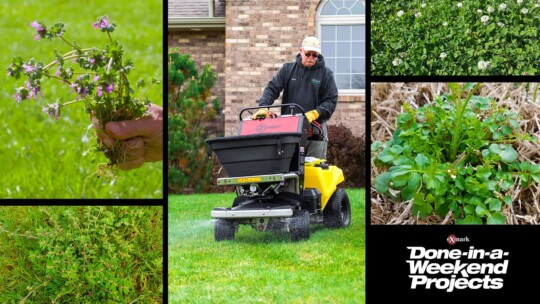
How to Determine the Correct Lawn Mower Height Settings
One of the most highly debated lawn care topics is also one of the most important: determining the correct lawn mower height settings for your yard. Unfortunately, there are almost as many opinions and perspectives on this topic as there are grass blades in your lawn. So where do you begin? This episode of Done-In-A-Weekend Projects has you covered. Tune in as host Doug Scott explains how high—or low—you should mow this season.
Cool-season vs. Warm-season: What’s the Difference?
Before you break out your Exmark for your mow, a refresher on what grass type you have in your lawn goes far. In short, grass is broken down into two main categories: cool- and warm-season. And where you live determines what you have.
Cool-season grasses, such as Kentucky bluegrass, tall and fine fescues, and perennial ryegrass, are typically found in northern, cooler climates. This area encompasses the upper two-thirds of the contiguous United States. Conversely, warm-season grasses (like Bermuda, zoysia, St. Augustine, and centipede), are found throughout the south.
And that’s not to mention the transitional zone. Bridging the cool- and warm-season zones, this area contains both types in abundance. To complicate matters even further, some homeowners in this zone can have both in one yard! So, it’s always best to know what you’re dealing with before you mow.
Benefits of Proper Mowing Height
As with nearly everything lawn and garden-related, lawn health is at the root of knowing the right cutting height. Grass blades cut at the correct height better capture light, rain, and nutrients.
Helping the root system grow deeper, denser, stronger, and healthier. If you mow too low, you run the risk of your lawn being burned by the sun, resulting in weak roots and a potential weed infestation. Mowing too high increases the chance of excess moisture buildup, creating an environment for pests and disease to take hold.
The Golden Rule
The key to determining the right height is achieving balance. And part of that balance is found in the “Golden Rule” of mowing: never cutting more than one-third of a blade off at a time.
There’s nothing more tempting than cutting straight to the ideal height on your first mow of the year—but that does your lawn way more harm than good. Gradually lowering your deck mow by mow keeps the balance between the blades and roots in check. Preventing your lawn from going into shock—and keeping everything green and pristine.
Correct Lawn Mower Height Settings per Grass Type
With all that established, it’s time to cut to the chase: the ideal mowing height for each grass type.
Warm-season grasses are more heat-tolerant, built to thrive—and grow—in the hot southern sun. So, it’s best to drop your deck height close to its lowest setting, keeping it between one to two inches. The shorter cut promotes denser lawn growth and helps fight back against pesky weeds.
If you have a cool-season lawn, you’ll want to keep it between the two-and-a-half to four-inch range. These grasses are hardy and well-adapted to frigid winters—but aren’t as heat tolerant. The extra length shades the soil from the summer sun, retaining vital moisture to help it withstand potential droughts or prolonged heat waves.
Lawn Mower Height Settings by Season
While knowing the range goes far in helping your lawn, knowing how your mowing height changes with the season goes even further.
Spring
For the first cut of spring, lower your deck by half an inch from your normal summer cutting height. So, if you have a fescue lawn you keep at four inches during the summer, drop it to three-and-a-half for your first mow. This removes any winter-burned blades and encourages new growth. However, make sure to follow the Golden Rule and use multiple cutting sessions, if needed, to ensure the best results.
Summer
Throughout the summer, mow on the higher end of your specified range. This protects the soil from the summer heat, while retaining the moisture your lawn needs.
Fall
As fall rolls around, stay the course with your summer mowing routine (especially if you have a warm-season lawn). For those with cool-season grass, this is your yard’s prime growing time, so it’s best to up your mowing frequency.
Then, as you come up on your last session of the year, end your cutting season as you started: lowering the height by half an inch. This helps protect the roots from the harsh cold winter weather and doesn’t run the risk of snow mold taking hold.
Winter
Finally, as the winter chill sets in, it’s time to put your mower away. Most grasses go dormant during this period, so it’s the perfect time to kick back, relax, and enjoy the season.
Or, if you live in a warmer climate, you can continue to enjoy the thrill of mowing—and everything else the backyard life has to offer.



